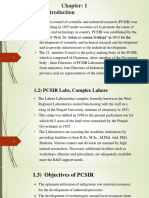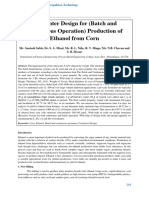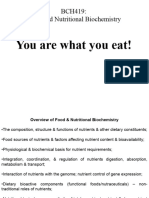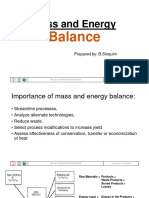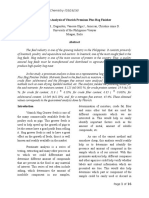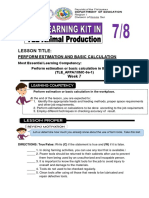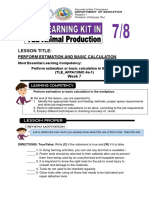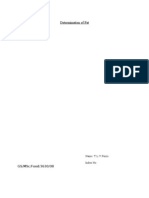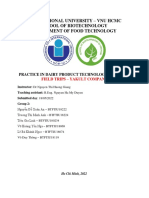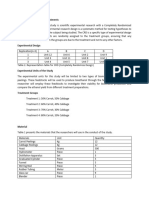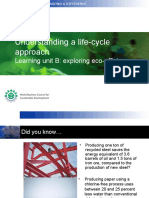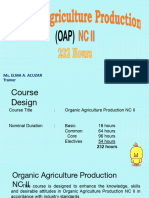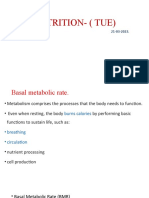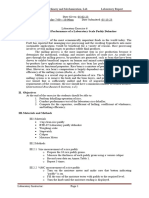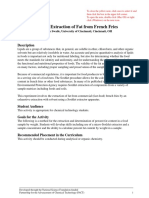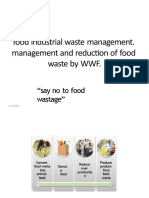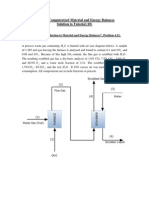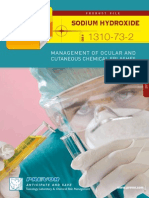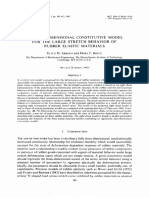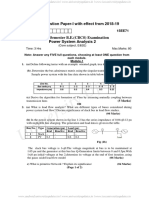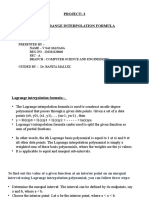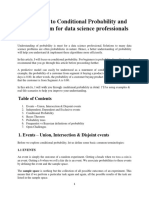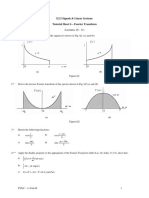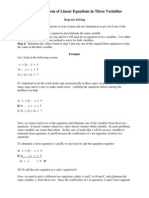Bab 03 MassBalance
Bab 03 MassBalance
Uploaded by
Muhammad Alfikri RidhatullahCopyright:
Available Formats
Bab 03 MassBalance
Bab 03 MassBalance
Uploaded by
Muhammad Alfikri RidhatullahCopyright
Available Formats
Share this document
Did you find this document useful?
Is this content inappropriate?
Copyright:
Available Formats
Bab 03 MassBalance
Bab 03 MassBalance
Uploaded by
Muhammad Alfikri RidhatullahCopyright:
Available Formats
8/24/2011
Purwiyatno Hariyadi/ITP/Fateta/IPB 1
Mass Balance Mass Balance Mass Balance Mass Balance
Lecture Note Lecture Note
Principles of Food Engineering Principles of Food Engineering Principles of Food Engineering Principles of Food Engineering
Dosen Dosen : :
Prof. Prof. Dr Dr. . Purwiyatno Purwiyatno Hariyadi Hariyadi, , MSc MSc
Dept of Food Dept of Food Sciemce & Sciemce & Technology Technology
Faculty of Agricultural Technology Faculty of Agricultural Technology y g gy y g gy
Bogor Agricultural University Bogor Agricultural University
BOGOR BOGOR
Mass Balance Learning Objectives Mass Balance Learning Objectives
Understand the fundamental mass balance Understand the fundamental mass balance
concepts concepts
Be able to list and discuss important mass Be able to list and discuss important mass
balance applications in food processing and balance applications in food processing and
handling operations handling operations
Be able to conceptually describe how mass Be able to conceptually describe how mass
Purwiyatno Purwiyatno Hariyadi Hariyadi/ITP/ /ITP/Fateta Fateta/IPB /IPB
p y p y
balance determinations or calculations are balance determinations or calculations are
obtained obtained
8/24/2011
Purwiyatno Hariyadi/ITP/Fateta/IPB 2
WHY STUDY MASS BALANCE??? WHY STUDY MASS BALANCE??? WHY STUDY MASS BALANCE??? WHY STUDY MASS BALANCE???
Fundamental for blending of ingredients in food Fundamental for blending of ingredients in food
processing operations processing operations
Law of conservation of Law of conservation of
mass : mass :
Matter is neither be created Matter is neither be created
nor destroyed nor destroyed
Fundamental for separation processes include: Fundamental for separation processes include:
oo evaporation evaporation
oo dehydration dehydration
oo distillation distillation
oo absorption absorption
Purwiyatno Purwiyatno Hariyadi Hariyadi/ITP/ /ITP/Fateta Fateta/IPB /IPB
nor destroyed nor destroyed
pp
oo ion exchange ion exchange
i t i t t t t t
Mass Balance : Concept ................... 1 Mass Balance : Concept ................... 1 Mass Balance : Concept ................... 1 Mass Balance : Concept ................... 1
Law of Conservation of Mass Law of Conservation of Mass
Input Input - - output = accumulation output = accumulation
accumulation accumulation
input input output output
Continuous/steady state processes : Continuous/steady state processes :
No accumulation of mass No accumulation of mass
Desired in large Desired in large--scale operations : scale operations :
process control : simpler process control : simpler
Purwiyatno Purwiyatno Hariyadi Hariyadi/ITP/ /ITP/Fateta Fateta/IPB /IPB
p ocess co t o s p e p ocess co t o s p e
product quality : easier to manage product quality : easier to manage
In small scale operations, batch processing of In small scale operations, batch processing of
ingredients is more common ingredients is more common
Combination of continuous and batch type Combination of continuous and batch type
operations sometimes used operations sometimes used
8/24/2011
Purwiyatno Hariyadi/ITP/Fateta/IPB 3
Mass Balance : Concept ................... 2 Mass Balance : Concept ................... 2 Mass Balance : Concept ................... 2 Mass Balance : Concept ................... 2
Yield concept Yield concept
Grinding of soybean Grinding of soybean
Results : 93 kg soy flour are produced from 100 kg Results : 93 kg soy flour are produced from 100 kg
soybean soybean
Yield : 93%. Yield : 93%.
(Bio)chemical reaction : Yield concept (Bio)chemical reaction : Yield concept
..... .....
>stoichiometry >stoichiometry
ex. C ex. C
66
HH
44
(CH (CH
33
))
22
+3O +3O
22
........ ........
>>CC
66
HH
44
(CO) (CO)
22
OO +3 H +3 H
22
OO
xylene (X) xylene (X) phthylic anhydride (Ph) phthylic anhydride (Ph)
Results : 108 kg of Ph are produced per 100 kg X Results : 108 kg of Ph are produced per 100 kg X
Yield?? Yield??
Purwiyatno Purwiyatno Hariyadi Hariyadi/ITP/ /ITP/Fateta Fateta/IPB /IPB
MW X =106 kg/kg mole MW X =106 kg/kg mole MW Ph =148 kg/kg mole MW Ph =148 kg/kg mole
100 kg X =100 kg(1 kg mole/106 kg) =0.944 kg mole 100 kg X =100 kg(1 kg mole/106 kg) =0.944 kg mole
108 kg Ph =108 kg(1kg mole/148 kg) =0.730 kg mole 108 kg Ph =108 kg(1kg mole/148 kg) =0.730 kg mole
Yield : (0.730/0.944)100% =77.3% Yield : (0.730/0.944)100% =77.3%
Yield?? Yield??
Draw a sketch or diagram describing process Draw a sketch or diagram describing process
Steps in Mass Balance Preparation Steps in Mass Balance Preparation
Identify information available Identify information available
Identify boundaries of system with dotted lines Identify boundaries of system with dotted lines
Identify all input (inflows) and output (outflows) Identify all input (inflows) and output (outflows)
Use symbols or letters to identify unknown items/quantities Use symbols or letters to identify unknown items/quantities
Write mass balance equation : Write mass balance equation :
h i t b i f l l ti h i t b i f l l ti
Purwiyatno Purwiyatno Hariyadi Hariyadi/ITP/ /ITP/Fateta Fateta/IPB /IPB
choose appropriate basis of calculation choose appropriate basis of calculation
do total and/or component mass balance do total and/or component mass balance
Solve resulting algebraic equation(s) Solve resulting algebraic equation(s)
8/24/2011
Purwiyatno Hariyadi/ITP/Fateta/IPB 4
Production of low fat cream (18% fat, w/w), from double Production of low fat cream (18% fat, w/w), from double
cream(48%fat w/w) and milk (3 5%w/w) cream(48%fat w/w) and milk (3 5%w/w)
Mass Balance Example 0 Mass Balance Example 0 Mass Balance Example 0 Mass Balance Example 0
cream (48% fat, w/w) and milk (3.5%,w/w). cream (48% fat, w/w) and milk (3.5%,w/w).
Howmuch double cream and milk are required to Howmuch double cream and milk are required to
produce 100 kg low fat cream? produce 100 kg low fat cream?
Purwiyatno Purwiyatno Hariyadi Hariyadi/ITP/ /ITP/Fateta Fateta/IPB /IPB
Mixer Mixer
Milk, 3.5% fat Milk, 3.5% fat
Low fat cream Low fat cream
18% fat 18% fat
100 kg 100 kg
Mass Balance Example 0 answer Mass Balance Example 0 answer Mass Balance Example 0 answer Mass Balance Example 0 answer
Cream, 48% Cream, 48%
100 kg 100 kg
Let the required double cream =y kg and milk =x kg Let the required double cream =y kg and milk =x kg
Total mass balance equation : Total mass balance equation :
y +x =100 kg y +x =100 kg . Eq.1 . Eq.1
The componen balance on the fat : The componen balance on the fat :
0 035x+0 48y=100(0 18) 0 035x+0 48y=100(0 18) Eq 2 Eq 2 0.035x +0.48y =100(0.18) 0.035x +0.48y =100(0.18) . Eq.2 . Eq.2
Eq. 1 and 2 : Eq. 1 and 2 : 0.035(100 0.035(100--y) +0.48y =18 y) +0.48y =18
3.5 3.5 - - 0.035y +0.48y =18 0.035y +0.48y =18
y =32.58 kg y =32.58 kg
jadi . jadi . X =67.42 kg X =67.42 kg
Purwiyatno Purwiyatno Hariyadi Hariyadi/ITP/ /ITP/Fateta Fateta/IPB /IPB
8/24/2011
Purwiyatno Hariyadi/ITP/Fateta/IPB 5
Mass Balance Example 1 Mass Balance Example 1 Mass Balance Example 1 Mass Balance Example 1
Drying of 500 kg/h of diced carrots Drying of 500 kg/h of diced carrots
D d ll l D d ll l fl d h d fl d h d Dryer used : parallel Dryer used : parallel--flow dehydrator flow dehydrator
Drying objective : moisture content 85% to 20% Drying objective : moisture content 85% to 20%
Air entering dehydrator Air entering dehydrator
air humidity ratio of 0.013 kg of water per kg of dry air humidity ratio of 0.013 kg of water per kg of dry
matter entering dehydrator at the rate of 200 kg of matter entering dehydrator at the rate of 200 kg of
air per kg of dr solid air per kg of dr solid
Purwiyatno Purwiyatno Hariyadi Hariyadi/ITP/ /ITP/Fateta Fateta/IPB /IPB
air per kg of dry solid air per kg of dry solid
Calculate humidity ratio of the air leaving dehydrator Calculate humidity ratio of the air leaving dehydrator
Mass Balance Example 1 .......... Answer (i) Mass Balance Example 1 .......... Answer (i) Mass Balance Example 1 .......... Answer (i) Mass Balance Example 1 .......... Answer (i)
Step 1. Draw a sketch or diagram describing process Step 1. Draw a sketch or diagram describing process
Air in Air in
Air out Air out
Dryer Dryer
Carrots in Carrots in
Carrots out Carrots out
Step 2. Identify boundaries of system with dotted lines Step 2. Identify boundaries of system with dotted lines
Step 3. Use symbols or letters to identify unknown Step 3. Use symbols or letters to identify unknown
yy
Purwiyatno Purwiyatno Hariyadi Hariyadi/ITP/ /ITP/Fateta Fateta/IPB /IPB
p y y p y y
items/quantities items/quantities
Let m represent total water contained in 1 kg dry Let m represent total water contained in 1 kg dry
leaving air leaving air
8/24/2011
Purwiyatno Hariyadi/ITP/Fateta/IPB 6
Step 4. Write mass balance equation Step 4. Write mass balance equation
Mass Balance Example 1 .......... Answer (ii) Mass Balance Example 1 .......... Answer (ii) Mass Balance Example 1 .......... Answer (ii) Mass Balance Example 1 .......... Answer (ii)
Air in Air in
Air out Air out
Dryer Dryer
Balance of water : Balance of water :
Total of water in =total of water out Total of water in =total of water out
(H (H O t H O t H O i ) O i ) (H (H O t ) O t )
Carrots in Carrots in
Carrots out Carrots out
yy
(H (H
22
O carrots +H O carrots +H
22
O air) O air)
in in
=(H =(H
22
O carrots +m) O carrots +m)
out out
Basis : 1 kg dry basis Basis : 1 kg dry basis
(H (H
22
O carrots) O carrots)
in in
: 85 parts of H : 85 parts of H
22
O 15 part of dry solids O 15 part of dry solids
for 1 kg of dry solids : 1.0(85/15) =5.67 kg H for 1 kg of dry solids : 1.0(85/15) =5.67 kg H
22
O O
Purwiyatno Purwiyatno Hariyadi Hariyadi/ITP/ /ITP/Fateta Fateta/IPB /IPB
Step 4. Write mass balance equation Step 4. Write mass balance equation
Mass Balance Example 1 .......... Answer (iii) Mass Balance Example 1 .......... Answer (iii) Mass Balance Example 1 .......... Answer (iii) Mass Balance Example 1 .......... Answer (iii)
Air in Air in
Air out Air out
Dryer Dryer
Carrots in Carrots in
Carrots out Carrots out
((200) kg dry air 200) kg dry air X X (0.013) kg water (0.013) kg water
k d lid k d i k d lid k d i
=2.6 kg H =2.6 kg H
22
OO
(H (H
22
O air) O air)
in in
: for 1 kg of dry solids : for 1 kg of dry solids
....... .......
>200 kg of dry air >200 kg of dry air
yy
Purwiyatno Purwiyatno Hariyadi Hariyadi/ITP/ /ITP/Fateta Fateta/IPB /IPB
kg dry solids kg dry air kg dry solids kg dry air
(H (H
22
O carrots) O carrots)
out out
: : 1.0(20/80) =0.25 kg H 1.0(20/80) =0.25 kg H
22
OO
8/24/2011
Purwiyatno Hariyadi/ITP/Fateta/IPB 7
Air in Air in
Air out Air out
Mass Balance Example 1 .......... Answer (iv) Mass Balance Example 1 .......... Answer (iv) Mass Balance Example 1 .......... Answer (iv) Mass Balance Example 1 .......... Answer (iv)
Dryer Dryer
5.67 kg water 5.67 kg water 2.6 kg of water 2.6 kg of water 0,25 kg of water 0,25 kg of water
kg dry solids kg dry solids kg dry solids kg dry solids kg dry solids kg dry solids
+m +m
== ++
Water balance equation : Water balance equation :
Carrots in Carrots in
Carrots out Carrots out
yy
kg dry solids kg dry solids kg dry solids kg dry solids kg dry solids kg dry solids
Step 5. Solve resulting algebraic equation Step 5. Solve resulting algebraic equation
5.67 +2.6 =0.25 +m 5.67 +2.6 =0.25 +m
8.02 kg water 8.02 kg water
kg dry solids kg dry solids
m =5.67 +2.6 m =5.67 +2.6 - - 0.25 = 0.25 =
Purwiyatno Purwiyatno Hariyadi Hariyadi/ITP/ /ITP/Fateta Fateta/IPB /IPB
Air in Air in
Air out Air out
Mass Balance Example 1 .......... Answer (v) Mass Balance Example 1 .......... Answer (v) Mass Balance Example 1 .......... Answer (v) Mass Balance Example 1 .......... Answer (v)
Dryer Dryer
humidity ratio, W humidity ratio, W
22
==
............... Moisture content of air leaving dehydrator ............... Moisture content of air leaving dehydrator
Carrots in Carrots in
Carrots out Carrots out
yy
==
8.02 8.02 kg water kg water
kg solids kg solids 8.02 kg water / kg solids 8.02 kg water / kg solids
200 200 kg dry air kg dry air 200 kg dry/kg solids 200 kg dry/kg solids
kg solids kg solids
0.04 kg water 0.04 kg water
kg dry air kg dry air
==
Purwiyatno Purwiyatno Hariyadi Hariyadi/ITP/ /ITP/Fateta Fateta/IPB /IPB
8/24/2011
Purwiyatno Hariyadi/ITP/Fateta/IPB 8
Contoh Soal Neraca Massa .....................2 Contoh Soal Neraca Massa .....................2 Contoh Soal Neraca Massa .....................2 Contoh Soal Neraca Massa .....................2
Contoh Contoh-- proses pencampuran sirup sorgum proses pencampuran sirup sorgum
Pencampuran sirup murni dengan sirup jagung dan Pencampuran sirup murni dengan sirup jagung dan
sirup sirup--semi untuk memperoleh 100 kg blended product semi untuk memperoleh 100 kg blended product
Berikut adalah karakteristik 3 macam sirup : Berikut adalah karakteristik 3 macam sirup :
Item Item %H %H
22
O %gula O %gula %Flavor %Flavor
Sirup Sorg Sirup Sorg 23.0 76.0 23.0 76.0 1.5 1.5
Sirup jgn Sirup jgn 20.0 80.0 20.0 80.0 0.0 0.0
Purwiyatno Purwiyatno Hariyadi Hariyadi/ITP/ /ITP/Fateta Fateta/IPB /IPB
Sirup Sirup--semi semi 40.0 60.0 40.0 60.0 1.0 1.0
Campuran Campuran 25.0 75.0 25.0 75.0 1.0 1.0
Input Input - - output =akumulasi output =akumulasi
Sirup sorgum Sirup sorgum
(murni) (murni)
Sirup jagung Sirup jagung
Sirup campuran Sirup campuran pencampuran pencampuran
Contoh Soal Neraca Massa .....................2 (jawab i) Contoh Soal Neraca Massa .....................2 (jawab i) Contoh Soal Neraca Massa .....................2 (jawab i) Contoh Soal Neraca Massa .....................2 (jawab i)
1. Gambar diagram proses 1. Gambar diagram proses
Sirup semi Sirup semi
p p p p pe ca pu a pe ca pu a
2. Identifikasi sistem 2. Identifikasi sistem
3. Gunakan simbol 3. Gunakan simbol- -simbol : simbol : S jumlah (kg) sirup sorgum murni S jumlah (kg) sirup sorgum murni
C jumlah (kg) sirup jagung C jumlah (kg) sirup jagung
P jumlah (kg) sirup semi P jumlah (kg) sirup semi
4. Tulis persamaan yang dihasilkan : 4. Tulis persamaan yang dihasilkan :
Diperlukan 3 pers neraca bahan; yaitu gula, flavor & total massa Diperlukan 3 pers neraca bahan; yaitu gula, flavor & total massa
Total Total : : S + C + P = 100 S + C + P = 100 ........... (1) ........... (1)
Gula Gula : : 0.76 S + 0.8 C + 0.6 P =0.75 x 100 = 75 0.76 S + 0.8 C + 0.6 P =0.75 x 100 = 75 ........... (2) ........... (2)
Flavor Flavor : : 0.015 S + 0 C + 0.01 P=0.01 x 100 = 1 0.015 S + 0 C + 0.01 P=0.01 x 100 = 1 ........... (3) ........... (3)
Purwiyatno Purwiyatno Hariyadi Hariyadi/ITP/ /ITP/Fateta Fateta/IPB /IPB
8/24/2011
Purwiyatno Hariyadi/ITP/Fateta/IPB 9
Total Total : : S + C + P = 100 S + C + P = 100 ........... (1) ........... (1)
Gula Gula : : 0.76 S + 0.8 C + 0.6 P =0.75 x 100 = 75 0.76 S + 0.8 C + 0.6 P =0.75 x 100 = 75 ........... (2) ........... (2)
Flavor Flavor : : 0.015 S + 0 C + 0.01 P=0.01 x 100 = 1 0.015 S + 0 C + 0.01 P=0.01 x 100 = 1 ........... (3) ........... (3)
Contoh Soal Neraca Massa .....................2 (jawab ii) Contoh Soal Neraca Massa .....................2 (jawab ii) Contoh Soal Neraca Massa .....................2 (jawab ii) Contoh Soal Neraca Massa .....................2 (jawab ii)
5. Pecahkan persamaan yang diperoleh 5. Pecahkan persamaan yang diperoleh
Pecahkan P pada pers (3) sebagai fungsi S : Pecahkan P pada pers (3) sebagai fungsi S :
P = 100 P = 100 - - 1.5 S 1.5 S
Substitusi nilai P dalam pers (1) : Substitusi nilai P dalam pers (1) :
S + C + 100 S + C + 100 - - 1.5 S = 100 1.5 S = 100
............ ............
> jadi, C = 0.5 S > jadi, C = 0.5 S
Substitusi nilai C dan P dalam pers (2) : Substitusi nilai C dan P dalam pers (2) :
0.76 S + 0.8(0.5 S) + 0.6(100 0.76 S + 0.8(0.5 S) + 0.6(100--1.5 S)=75 1.5 S)=75
0.26 S = 15; 0.26 S = 15;
....................................................... .......................................................
> jadi, S = 57.69 > jadi, S = 57.69
Pecahkan nilai C dan P : Pecahkan nilai C dan P :
C = 0.5 S = 0.5 (57.69) = 28.85 C = 0.5 S = 0.5 (57.69) = 28.85
P = 100 P = 100- -1.5S = 100 1.5S = 100 - - 1.5(57.69) = 13.46 1.5(57.69) = 13.46
Jadi, campuran itu adalah : Jadi, campuran itu adalah :
S + C + P = 57.69 + 28.85 + 13.46 =100 S + C + P = 57.69 + 28.85 + 13.46 =100
Purwiyatno Purwiyatno Hariyadi Hariyadi/ITP/ /ITP/Fateta Fateta/IPB /IPB
Example Example Example Example
Production of low fat cream (18% fat, w/w), from double Production of low fat cream (18% fat, w/w), from double
cream(48%fat w/w) and milk (3 5%w/w) cream(48%fat w/w) and milk (3 5%w/w) cream (48% fat, w/w) and milk (3.5%,w/w). cream (48% fat, w/w) and milk (3.5%,w/w).
Howmuch double cream and milk are required to Howmuch double cream and milk are required to
produce 100 kg low fat cream? produce 100 kg low fat cream?
Purwiyatno Purwiyatno Hariyadi Hariyadi/ITP/ /ITP/Fateta Fateta/IPB /IPB
8/24/2011
Purwiyatno Hariyadi/ITP/Fateta/IPB 10
Mixer Mixer
Cream 48% Cream 48%
Milk, 3.5% fat Milk, 3.5% fat
Low fat cream Low fat cream
18% fat 18% fat
100 kg 100 kg
Answer : Answer :
Cream, 48% Cream, 48%
Let the required double cream =y kg and milk =x kg Let the required double cream =y kg and milk =x kg
Total mass balance equation : Total mass balance equation :
y +x =100 kg y +x =100 kg . Eq.1 . Eq.1
The componen balance on the fat : The componen balance on the fat :
0 035 0 48 100(0 18) 0 035 0 48 100(0 18) E 2 E 2 0.035x +0.48y =100(0.18) 0.035x +0.48y =100(0.18) . Eq.2 . Eq.2
Eq. 1 and 2 : Eq. 1 and 2 : 0.035(100 0.035(100--y) +0.48y =18 y) +0.48y =18
3.5 3.5 - - 0.035y +0.48y =18 0.035y +0.48y =18
y =32.58 kg y =32.58 kg
jadi . jadi . X =67.42 kg X =67.42 kg
Purwiyatno Purwiyatno Hariyadi Hariyadi/ITP/ /ITP/Fateta Fateta/IPB /IPB
A fruit puree is dried in a continuous flow dehydrator.
Th t t i 0 80 H O/k hil th d i d
Mass Balance Example 3 Mass Balance Example 3
............................................................. DO IT!
Mass Balance Example 3 Mass Balance Example 3
............................................................. DO IT!
The wet puree contains 0.80 H
2
O/kg puree while the dried
puree contains 0.20 kg H
2
O/kg puree.
Flow rates of wet puree entering the dehydrator is 100 kg/h
while dry puree leaving the dehydrator is 25 kg/h .
Heated drying air flows opposite to flow of the puree.
Moisture content of drying air entering and leaving the drier
are 0 01 and 0 02 kg H2O/kg respectively
Purwiyatno Hariyadi/ITP/Fateta/IPB
are 0.01 and 0.02 kg H2O/kg, respectively.
What is the flow rate of drying air?
8/24/2011
Purwiyatno Hariyadi/ITP/Fateta/IPB 11
Mass Balance Example 3 .......... Answer (i) Mass Balance Example 3 .......... Answer (i) Mass Balance Example 3 .......... Answer (i) Mass Balance Example 3 .......... Answer (i)
Step 1. Draw a sketch or diagram describing process Step 1. Draw a sketch or diagram describing process
Air Out Air Out
Drying air In Drying air In
Drier Drier
Puree in Puree in
Puree out Puree out
Step 2. Identify boundaries of system with dotted lines Step 2. Identify boundaries of system with dotted lines
Drier Drier
Input Input : : puree in (0.80 H puree in (0.80 H
22
O/kg puree), at 100 kg/h O/kg puree), at 100 kg/h
drying air in (0.01 kg H drying air in (0.01 kg H
22
O/kg) O/kg)
Purwiyatno Purwiyatno Hariyadi Hariyadi/ITP/ /ITP/Fateta Fateta/IPB /IPB
Step 3. Use symbols or letters to identify unknown Step 3. Use symbols or letters to identify unknown
items/quantities items/quantities
Let X kg/h represent the flow rate of drying air? Let X kg/h represent the flow rate of drying air?
Output Output : : dried puree (0.20 kg H dried puree (0.20 kg H
22
O/kg puree), at 25 kg/h O/kg puree), at 25 kg/h
drying air out (0.02 kg H drying air out (0.02 kg H
22
O/kg) O/kg)
Mass Balance Example 3 .......... Answer (ii) Mass Balance Example 3 .......... Answer (ii) Mass Balance Example 3 .......... Answer (ii) Mass Balance Example 3 .......... Answer (ii)
Air Out Air Out
Drying air In Drying air In
Step 4. Write mass balance equation Step 4. Write mass balance equation
Puree in Puree in
Puree out Puree out
Balance for water : Water Balance for water : Water
IN IN
= Water = Water
OUT OUT
Basis : 1 h Basis : 1 h
x kg DA (0.01 kg H x kg DA (0.01 kg H
22
O /kg DA) + 100 kg puree (0.8kg H O /kg DA) + 100 kg puree (0.8kg H
22
O /kg puree) = O /kg puree) =
k DA (0 02 k H k DA (0 02 k H O /k DA) 25 k (0 2 k H O /k DA) 25 k (0 2 k H O/k ) O/k )
Purwiyatno Purwiyatno Hariyadi Hariyadi/ITP/ /ITP/Fateta Fateta/IPB /IPB
x kg DA (0.02 kg H x kg DA (0.02 kg H
22
O /kg DA) + 25 kg puree (0.2 kg H O /kg DA) + 25 kg puree (0.2 kg H
22
O/kg puree) O/kg puree)
0.01x + 80 = 0.02x + 5 0.01x + 80 = 0.02x + 5
x = 75/0.01 = 7500 x = 75/0.01 = 7500
Flow rate of drying air = 7500 kg/h Flow rate of drying air = 7500 kg/h
8/24/2011
Purwiyatno Hariyadi/ITP/Fateta/IPB 12
MATERIAL BALANCE FOR COMPLEX PROCESSING MATERIAL BALANCE FOR COMPLEX PROCESSING MATERIAL BALANCE FOR COMPLEX PROCESSING MATERIAL BALANCE FOR COMPLEX PROCESSING
Example of sugar crystallization Example of sugar crystallization
Determine the amount of sugar that can be produced from Determine the amount of sugar that can be produced from
100,kg of sugar solution containing 20% (w/w) sugar, 1% 100,kg of sugar solution containing 20% (w/w) sugar, 1%
(w/w) water soluble (uncrystallizable) impurity. (w/w) water soluble (uncrystallizable) impurity.
The process are as the following : The process are as the following :
Solution is concentrated to 75% sugar, cooled to 20 Solution is concentrated to 75% sugar, cooled to 20
oo
C, C,
and centrifuged and the crystals are then dried and centrifuged and the crystals are then dried
Purwiyatno Purwiyatno Hariyadi Hariyadi/ITP/ /ITP/Fateta Fateta/IPB /IPB
and centrifuged, and the crystals are then dried. and centrifuged, and the crystals are then dried.
1. Diagram 1. Diagram 1. Diagram 1. Diagram
Evaporator Evaporator Crystallizer Crystallizer Centrifuge Centrifuge Drier Drier
HH
22
OO
AA
HH
22
OO
BB
Evaporator Evaporator Crystallizer Crystallizer Centrifuge Centrifuge Drier Drier
Raw Raw
sugar sugar
soln soln
A : concentrated sugar soln (75% sugar,w/w) A : concentrated sugar soln (75% sugar,w/w)
Dry Dry
sugar sugar
B : wet sugar crystal B : wet sugar crystal
CC
C : low concentration sugar soln C : low concentration sugar soln
2. Identify system? 2. Identify system?
Purwiyatno Purwiyatno Hariyadi Hariyadi/ITP/ /ITP/Fateta Fateta/IPB /IPB
gg
8/24/2011
Purwiyatno Hariyadi/ITP/Fateta/IPB 13
Evaporator Evaporator Crystallizer Crystallizer Centrifuge Centrifuge Drier Drier
HH
22
OO
AA
BB
HH
22
OO
System a : System a : System a : System a :
Evaporator Evaporator Crystallizer Crystallizer Centrifuge Centrifuge Drier Drier
Raw Raw
sugar sugar
soln soln
CC
Dry Dry
sugar sugar
Input Input : : rawsugar soln rawsugar soln
Output Output: : H H
22
O (fromevaporator) O (fromevaporator)
HHO (f di ) O (f di ) HH
22
O (fromdrier) O (fromdrier)
C : lowconcentration sugar soln C : lowconcentration sugar soln
dry sugar dry sugar
Purwiyatno Purwiyatno Hariyadi Hariyadi/ITP/ /ITP/Fateta Fateta/IPB /IPB
Evaporator Evaporator Crystallizer Crystallizer Centrifuge Centrifuge Drier Drier
HH
22
OO
AA
BB
HH
22
OO
System b : System b : System b : System b :
Evaporator Evaporator Crystallizer Crystallizer Centrifuge Centrifuge Drier Drier
Raw Raw
sugar sugar
soln soln
CC
Dry Dry
sugar sugar
Input Input : : concentrated sugar soln (75%sugar,w/w) concentrated sugar soln (75%sugar,w/w)
Output Output: : H H
22
O (fromdrier) O (fromdrier)
C l t ti l C l t ti l C : lowconcentration sugar soln C : lowconcentration sugar soln
dry sugar dry sugar
Purwiyatno Purwiyatno Hariyadi Hariyadi/ITP/ /ITP/Fateta Fateta/IPB /IPB
8/24/2011
Purwiyatno Hariyadi/ITP/Fateta/IPB 14
Evaporator Evaporator Crystallizer Crystallizer Centrifuge Centrifuge Drier Drier
HH
22
OO
AA
BB
HH
22
OO
System c : System c : System c : System c :
Evaporator Evaporator Crystallizer Crystallizer Centrifuge Centrifuge Drier Drier
Raw Raw
sugar sugar
soln soln
CC
Dry Dry
sugar sugar
Input Input : : B ( wet sugar crystal) B ( wet sugar crystal)
Output Output: : H H
22
O (fromdrier) O (fromdrier)
d d dry sugar dry sugar
Purwiyatno Purwiyatno Hariyadi Hariyadi/ITP/ /ITP/Fateta Fateta/IPB /IPB
MASS BALANCE EXAMPLE 4. MASS BALANCE EXAMPLE 4. MASS BALANCE EXAMPLE 4. MASS BALANCE EXAMPLE 4.
Crystallization of 100 kg of a concentrated sugar soln (85% Crystallization of 100 kg of a concentrated sugar soln (85% Crystallization of 100 kg of a concentrated sugar soln (85% Crystallization of 100 kg of a concentrated sugar soln (85%
sugar and 1 % inert, water soluble impurities. sugar and 1 % inert, water soluble impurities.
After cooling (crystallization), mixture was then centrifuged After cooling (crystallization), mixture was then centrifuged
to separate crystal and a liquid fraction (mother liquor). to separate crystal and a liquid fraction (mother liquor).
Mother liquor contain 60% sucrose (w/w). Crystals slurry Mother liquor contain 60% sucrose (w/w). Crystals slurry
contain 20% (w/w) mother liquor. contain 20% (w/w) mother liquor. ( ) q ( ) q
Do mass balance analysis for the process! Do mass balance analysis for the process!
Purwiyatno Purwiyatno Hariyadi Hariyadi/ITP/ /ITP/Fateta Fateta/IPB /IPB
8/24/2011
Purwiyatno Hariyadi/ITP/Fateta/IPB 15
1. Diagram 1. Diagram
Crystallizer Crystallizer Centrifuge Centrifuge
Conc. Sugar soln Conc. Sugar soln
Crystal slurry Crystal slurry
MASS BALANCE EXAMPLE 4................answer (i) MASS BALANCE EXAMPLE 4................answer (i) MASS BALANCE EXAMPLE 4................answer (i) MASS BALANCE EXAMPLE 4................answer (i)
Mother liquor Mother liquor
2. Identify system 2. Identify system
Input Input : : Conc. Sugar soln Conc. Sugar soln
(100 kg, 85% sucrose, 1% impurities, 14% water) (100 kg, 85% sucrose, 1% impurities, 14% water)
Output Output : : Crystal slurry (20% mother liquor) Crystal slurry (20% mother liquor)
Mother liquor (60% sucrose) Mother liquor (60% sucrose)
3. Symbol : 3. Symbol :
let let S = total mass of conc. Sugar soln S = total mass of conc. Sugar soln
C = total mass of crystal produced C = total mass of crystal produced
M = total mass of mother liquor produced M = total mass of mother liquor produced
Purwiyatno Purwiyatno Hariyadi Hariyadi/ITP/ /ITP/Fateta Fateta/IPB /IPB
Crystallizer Crystallizer Centrifuge Centrifuge
Conc. Sugar soln Conc. Sugar soln
Crystal slurry Crystal slurry
4. Mass balance equations 4. Mass balance equations
MASS BALANCE EXAMPLE 4................answer (ii) MASS BALANCE EXAMPLE 4................answer (ii) MASS BALANCE EXAMPLE 4................answer (ii) MASS BALANCE EXAMPLE 4................answer (ii)
Mother liquor Mother liquor Total mass balance : Total mass balance :
S =C +M S =C +M ............................ Eq. 1 ............................ Eq. 1
Balance of sucrose : Balance of sucrose :
0.85S =0.6M +[ 0.8(C) +0.2(C)0.6 ] 0.85S =0.6M +[ 0.8(C) +0.2(C)0.6 ] ............................ Eq. 2 ............................ Eq. 2
B l f t B l f t Balance of water : Balance of water :
let x = mass fraction impurities in mother liquor let x = mass fraction impurities in mother liquor
0.14S =M (0.4 0.14S =M (0.4- -x) +C(0.2)(0.4 x) +C(0.2)(0.4- -x) x) ............................ Eq. 3 ............................ Eq. 3
Balance of Impurities : Balance of Impurities :
0.01S =M(x) +0.2C(x) 0.01S =M(x) +0.2C(x) ............................ Eq. 4 ............................ Eq. 4
....... 3 unknown, 4 equation!! ....... 3 unknown, 4 equation!!
Purwiyatno Purwiyatno Hariyadi Hariyadi/ITP/ /ITP/Fateta Fateta/IPB /IPB
8/24/2011
Purwiyatno Hariyadi/ITP/Fateta/IPB 16
BASIS AND TIE MATERIAL BASIS AND TIE MATERIAL BASIS AND TIE MATERIAL BASIS AND TIE MATERIAL
Basis of calculation : Basis of calculation :
-- important if no initial quantities are given important if no initial quantities are given
-- important for continuous process important for continuous process
Tie Material : Tie Material :
Component used to relate the quantity of one Component used to relate the quantity of one
process stream to the quantity of another process stream to the quantity of another
Usually : component that does not change during Usually : component that does not change during Usually : component that does not change during Usually : component that does not change during
process process
* solid in dehydration process * solid in dehydration process
* solid in evaporation process * solid in evaporation process
Purwiyatno Purwiyatno Hariyadi Hariyadi/ITP/ /ITP/Fateta Fateta/IPB /IPB
RECYCLING ?? .... Toledo p.77 RECYCLING ?? .... Toledo p.77 RECYCLING ?? .... Toledo p.77 RECYCLING ?? .... Toledo p.77
Falling film evaporator, capacity 10 kg water/h. Falling film evaporator, capacity 10 kg water/h.
Feed enters at 5.5% solids and a 25% solid is desired. Feed enters at 5.5% solids and a 25% solid is desired.
To do that, system of recycling was used, at wich recycling To do that, system of recycling was used, at wich recycling
pump moves 20 kg/h og fluid into the evaporator. pump moves 20 kg/h og fluid into the evaporator.
Caculate : Caculate :
a. a. the feed rate the feed rate
b. b. concentrate production rate concentrate production rate
t f t t l d t f t t l d c. c. amount of concentrate recycled amount of concentrate recycled
d. d. concentration of mixture of feed and recycled concentration of mixture of feed and recycled
concentrate concentrate
Purwiyatno Purwiyatno Hariyadi Hariyadi/ITP/ /ITP/Fateta Fateta/IPB /IPB
8/24/2011
Purwiyatno Hariyadi/ITP/Fateta/IPB 17
8/24/2011
Purwiyatno Hariyadi/ITP/Fateta/IPB 18
1. Boundary of the system ? 1. Diagram?
evaporator
Input :
RECYCLING ?? .... Toledo p.77 ....... Answer (i) RECYCLING ?? .... Toledo p.77 ....... Answer (i) RECYCLING ?? .... Toledo p.77 ....... Answer (i) RECYCLING ?? .... Toledo p.77 ....... Answer (i)
evaporator
Liquid
reciever
Condensor
condensate
Feed (5.5 % solids)
Output :
Condensate : 10 kg/h
Concentrate
3. Symbols?
Feed
Recirculating
pump
concentrate
Feed rate =F
Condensate rate =V=10
Concentrate rate =C
Purwiyatno Purwiyatno Hariyadi Hariyadi/ITP/ /ITP/Fateta Fateta/IPB /IPB
RECYCLING ?? .... Toledo p.77 ....... Answer (ii) RECYCLING ?? .... Toledo p.77 ....... Answer (ii) RECYCLING ?? .... Toledo p.77 ....... Answer (ii) RECYCLING ?? .... Toledo p.77 ....... Answer (ii)
4. Mass balance equation(s) 4. Mass balance equation(s)
Total mass balance : Total mass balance :
F =C +V =C +10 ....... Eq.1 F =C +V =C +10 ....... Eq.1
Balance of Solid : Balance of Solid :
evaporator
Balance of Solid : Balance of Solid :
0.055F =0.25C ....... Eq. 2 0.055F =0.25C ....... Eq. 2
5. Solve the equations 5. Solve the equations
Eq.2. F =(0.25/0.055)C Eq.2. F =(0.25/0.055)C
F =4.545C ..... Eq.3 F =4.545C ..... Eq.3
Eq.1dan 3 : Eq.1dan 3 :
evaporator
Liquid
reciever
Condensor
condensate
Eq.1 dan 3 : Eq.1 dan 3 :
4.545C =C +10 4.545C =C +10
C =10/3.545 =2.52 C =10/3.545 =2.52
J adi concentrate rate J adi concentrate rate
=2.52 kg/h =2.52 kg/h
Purwiyatno Purwiyatno Hariyadi Hariyadi/ITP/ /ITP/Fateta Fateta/IPB /IPB
Feed
Recirculating
pump
concentrate
8/24/2011
Purwiyatno Hariyadi/ITP/Fateta/IPB 19
evaporator evaporator
RECYCLING ?? .... Toledo p.77 ....... Answer (iii) RECYCLING ?? .... Toledo p.77 ....... Answer (iii) RECYCLING ?? .... Toledo p.77 ....... Answer (iii) RECYCLING ?? .... Toledo p.77 ....... Answer (iii)
Back to eq.3.
evaporator evaporator
Liquid Liquid
reciever reciever
Condensor Condensor
condensate condensate
F =4.545C
=4.545(2.82)
=12.82
Feed rate =12.82 kg/h
To answer question c and
d we need to change the
Feed Feed
Recirculating Recirculating
pump pump
concentrate concentrate
d, we need to change the
(boundary of) system
analyzed
Purwiyatno Purwiyatno Hariyadi Hariyadi/ITP/ /ITP/Fateta Fateta/IPB /IPB
evaporator evaporator
RECYCLING ?? .... Toledo p.77 ....... Answer (iv) RECYCLING ?? .... Toledo p.77 ....... Answer (iv) RECYCLING ?? .... Toledo p.77 ....... Answer (iv) RECYCLING ?? .... Toledo p.77 ....... Answer (iv)
See the new system,
arround the evaporator
evaporator evaporator
Liquid Liquid
reciever reciever
Condensor Condensor
condensate condensate
Input :
Feed +Recycled
(20 kg/h)
Output :
Condensate
V =10 kg/h
Concentrate total
Feed Feed
Recirculating Recirculating
pump pump
concentrate concentrate
Concentrate total
(25% solid)
Purwiyatno Purwiyatno Hariyadi Hariyadi/ITP/ /ITP/Fateta Fateta/IPB /IPB
8/24/2011
Purwiyatno Hariyadi/ITP/Fateta/IPB 20
evaporator evaporator
RECYCLING ?? .... Toledo p.77 ....... Answer (v) RECYCLING ?? .... Toledo p.77 ....... Answer (v) RECYCLING ?? .... Toledo p.77 ....... Answer (v) RECYCLING ?? .... Toledo p.77 ....... Answer (v)
Let total concentrate =Ct
Balance of total mass :
F+R =20 =V +Ct
evaporator evaporator
Liquid Liquid
reciever reciever
Condensor Condensor
condensate condensate
12.82 +R =20 =10 +Ct
R =7.18
(amount of concentrate amount of concentrate
recycled recycled : 7.18 kg/h)
d. concentration of mixture of d. concentration of mixture of
feed and recycled feed and recycled
concentrate concentrate ? x
Feed Feed
Recirculating Recirculating
pump pump
concentrate concentrate
Ct =20-10 =10
x(20) =10(0.25)
x =2.5/20 =0.125
Concentration =12.5%
Purwiyatno Purwiyatno Hariyadi Hariyadi/ITP/ /ITP/Fateta Fateta/IPB /IPB
You might also like
- Chemical Engineering: Summer@Brown 2011Document46 pagesChemical Engineering: Summer@Brown 2011edward378No ratings yet
- Presentation 1Document76 pagesPresentation 1shahbano farhanNo ratings yet
- JPT 18 Santosh+Sable 11 1552Document14 pagesJPT 18 Santosh+Sable 11 1552Nizar MousaNo ratings yet
- Part I: Goal Definition: SIFS: PP2 - Eggplant Group 2Document3 pagesPart I: Goal Definition: SIFS: PP2 - Eggplant Group 2Eva CabreraNo ratings yet
- ID5200 Assignment 4 - CE20B017Document5 pagesID5200 Assignment 4 - CE20B017Aryamaan SinghNo ratings yet
- Standard Costing ExercisesDocument4 pagesStandard Costing ExercisesSheyni GandaNo ratings yet
- G8 Lesson 2.1Document35 pagesG8 Lesson 2.1Ima blinkNo ratings yet
- Analytical Tools in Nutrition..Document5 pagesAnalytical Tools in Nutrition..Huzaifa CHNo ratings yet
- Poultry Production Jairus Patrick RodilDocument5 pagesPoultry Production Jairus Patrick Rodilirish nicole pacionNo ratings yet
- PresentaciónDocument4 pagesPresentaciónyolethNo ratings yet
- Final BMS PROJECTDocument27 pagesFinal BMS PROJECTHARSH GUPTANo ratings yet
- Topic 2 Material BalancesDocument40 pagesTopic 2 Material BalanceshkumosesmedNo ratings yet
- Biotech New Normal Agribusiness Final v2Document36 pagesBiotech New Normal Agribusiness Final v2Bidur Prasad ChaulagainNo ratings yet
- BCH419 2023 24Document100 pagesBCH419 2023 24idriscognitoleadsNo ratings yet
- ABE 143 Mass and Energy BalanceDocument11 pagesABE 143 Mass and Energy Balanceaguilarsherremae22No ratings yet
- Biotechnology 9Document13 pagesBiotechnology 9kmmrvNo ratings yet
- Principles of Food Preservation, ProcessingDocument31 pagesPrinciples of Food Preservation, Processingrameshbptl100% (1)
- Anaerobic Digestion System Control Via Fuzzy LogicDocument25 pagesAnaerobic Digestion System Control Via Fuzzy LogicDanny TanNo ratings yet
- Introduction To Material and Energy BalnceDocument8 pagesIntroduction To Material and Energy BalnceMuhammad BurhanNo ratings yet
- ChE Calc Chapter - 4 PDFDocument46 pagesChE Calc Chapter - 4 PDFJatskinesisNo ratings yet
- A Mini Project Report ON: Kitchen Waste ComposterDocument13 pagesA Mini Project Report ON: Kitchen Waste ComposterHarshal DateyNo ratings yet
- Material Balance With Chemical ReactionDocument36 pagesMaterial Balance With Chemical ReactionKuldeep Bhatt100% (1)
- Paul GreeneDocument27 pagesPaul GreeneLiuJalu100% (1)
- Proximate AnalysisDocument16 pagesProximate Analysisvanessa olgaNo ratings yet
- Precess CalculationDocument39 pagesPrecess CalculationdhruvNo ratings yet
- Lesson Title:: Perform Estimation and Basic CalculationDocument8 pagesLesson Title:: Perform Estimation and Basic Calculationlady catherine enriquezNo ratings yet
- TLE Animal Prod 7&8 Q1 Week 7Document8 pagesTLE Animal Prod 7&8 Q1 Week 7lady catherine enriquezNo ratings yet
- Determination of FatDocument5 pagesDetermination of FatLaksilu Viduraga Peiris100% (1)
- Dairy Field Trip Yakult Group 2Document13 pagesDairy Field Trip Yakult Group 2Phương ThảoNo ratings yet
- KelseyBeyer FinalReportII 19dec2013Document15 pagesKelseyBeyer FinalReportII 19dec2013clashnerdczarNo ratings yet
- Capstone 1Document5 pagesCapstone 1andresallina0No ratings yet
- Lecture 2Document30 pagesLecture 2Ahmed EssamNo ratings yet
- Q1 - GenChem1 - Learning Packet4 - Calculating Percent Yield Theoretical Yield and Limiting ReagentDocument13 pagesQ1 - GenChem1 - Learning Packet4 - Calculating Percent Yield Theoretical Yield and Limiting Reagentnonatolyka75No ratings yet
- Proposal On Food Waste To Energy Conversion (Biodiesel)Document17 pagesProposal On Food Waste To Energy Conversion (Biodiesel)Abdulaziz Khalil100% (1)
- Understanding A Life-Cycle Approach: Learning Unit B: Exploring Eco-EfficiencyDocument24 pagesUnderstanding A Life-Cycle Approach: Learning Unit B: Exploring Eco-Efficiencymanushakya_shakyaNo ratings yet
- Laporan PhyxioEx METEND - Rohid AlfazonDocument27 pagesLaporan PhyxioEx METEND - Rohid AlfazonZayne GamingNo ratings yet
- OAP HandoutsDocument1,043 pagesOAP HandoutsMargarita OrlinaNo ratings yet
- Tuesday Nutrition 21-3-23.Document75 pagesTuesday Nutrition 21-3-23.Sanjeev walvekarNo ratings yet
- ABE 30 Lab Exercise 6 Operation and Performance of A Laboratory Scale Paddy DehuskerDocument7 pagesABE 30 Lab Exercise 6 Operation and Performance of A Laboratory Scale Paddy DehuskerBryan Buno100% (1)
- 8 Tle Food Processing q4 w5Document9 pages8 Tle Food Processing q4 w5katt100% (1)
- Introduction To Bioreactor DesignDocument34 pagesIntroduction To Bioreactor DesignLovingNo ratings yet
- Material Balance Without Chemical Reaction.Document81 pagesMaterial Balance Without Chemical Reaction.Kuldeep Bhatt33% (3)
- AGE09 - N - Lesson 13 - LContentDocument10 pagesAGE09 - N - Lesson 13 - LContentalwaysremembering14No ratings yet
- SoxhletExtraction PDFDocument7 pagesSoxhletExtraction PDFJim VelNo ratings yet
- Lab Report Exp 2Document12 pagesLab Report Exp 2Syuhada Aminuddin0% (2)
- Biology Form 4 Paper 3 Quiz & AnsDocument18 pagesBiology Form 4 Paper 3 Quiz & Anskhangsiean8967% (3)
- How Sustainable Is Organic Agriculture in The Phils Rodel G. Maghirang Et AlDocument180 pagesHow Sustainable Is Organic Agriculture in The Phils Rodel G. Maghirang Et AlAbner Obniala Venus Jr.No ratings yet
- TLE 8 Presentation 1Document45 pagesTLE 8 Presentation 16smww4w9p4No ratings yet
- Lecture Note 1 Student Ver.Document44 pagesLecture Note 1 Student Ver.A4blackNo ratings yet
- Biorefinery Concept Development Based On Wheat Flour MillingDocument23 pagesBiorefinery Concept Development Based On Wheat Flour Millingpedro41No ratings yet
- Mass and Energy Balances Chapter 4.5Document24 pagesMass and Energy Balances Chapter 4.5Ferat BotNo ratings yet
- Food Industrial Waste Management. Management and Reduction of Food Waste by WWFDocument100 pagesFood Industrial Waste Management. Management and Reduction of Food Waste by WWFShakir UllahNo ratings yet
- Module 1 - Introduction To orDocument26 pagesModule 1 - Introduction To orsrk bhaiNo ratings yet
- Unit 1,2&3 Fpo ModuleDocument21 pagesUnit 1,2&3 Fpo ModuleAna Yloisa B. BorigaNo ratings yet
- 8.feed Quality and Treatment.Document51 pages8.feed Quality and Treatment.Muhamad farhanNo ratings yet
- Part 5 BiofuelsDocument39 pagesPart 5 BiofuelsyahmedpersNo ratings yet
- Statistical Process Control for the Food Industry: A Guide for Practitioners and ManagersFrom EverandStatistical Process Control for the Food Industry: A Guide for Practitioners and ManagersNo ratings yet
- Sustainable Food ProcessingFrom EverandSustainable Food ProcessingBrijesh K. TiwariNo ratings yet
- Process Block Diagram Oleochemicals (Rev. 0)Document4 pagesProcess Block Diagram Oleochemicals (Rev. 0)Muhammad Alfikri RidhatullahNo ratings yet
- Tutorial 10 (Problem 4.21)Document6 pagesTutorial 10 (Problem 4.21)Muhammad Alfikri RidhatullahNo ratings yet
- Files MSDS Ca CL 2Document5 pagesFiles MSDS Ca CL 2Muhammad Alfikri RidhatullahNo ratings yet
- Games Mentoring IslamDocument126 pagesGames Mentoring IslamWanto Indra Purwanto0% (1)
- Sodium Hydroxide BookletDocument24 pagesSodium Hydroxide BookletbbmokshNo ratings yet
- Phenolphthalein PDFDocument3 pagesPhenolphthalein PDFMuhammad Alfikri RidhatullahNo ratings yet
- A Three-Dimensional Constitutive Model For The Large Stretch Behavior of Rubber Elastic MaterialsDocument24 pagesA Three-Dimensional Constitutive Model For The Large Stretch Behavior of Rubber Elastic MaterialsoreamigNo ratings yet
- Newton's Laws of Motion: Law of Inertia and Law of AccelerationDocument4 pagesNewton's Laws of Motion: Law of Inertia and Law of AccelerationLougene CastroNo ratings yet
- 15ee71 Question Paper VtuDocument5 pages15ee71 Question Paper VtuPuneeth N RanapurNo ratings yet
- No2 PDFDocument10 pagesNo2 PDFsanjog kshetriNo ratings yet
- Marking Scheme Physics Trial SPM SBP 2016 Paper 3 PDFDocument6 pagesMarking Scheme Physics Trial SPM SBP 2016 Paper 3 PDFkingNo ratings yet
- CP 20 CHEM C Experiment1Document22 pagesCP 20 CHEM C Experiment1MalapNo ratings yet
- U X, U Y, V X and V y U X V y and V X U Y: Unit Ii - Analytical Functions Part - ADocument13 pagesU X, U Y, V X and V y U X V y and V X U Y: Unit Ii - Analytical Functions Part - ACurious ManNo ratings yet
- Project:-3 Lagrange Interpolation FormulaDocument6 pagesProject:-3 Lagrange Interpolation FormulaAnkita PradhanNo ratings yet
- Material Derivative - WikipediaDocument20 pagesMaterial Derivative - Wikipediasterling goinNo ratings yet
- Solar RadiationDocument30 pagesSolar RadiationHiren Kumar0% (1)
- S-11 - Random Variables and Discrete Probability DistributionsDocument24 pagesS-11 - Random Variables and Discrete Probability Distributions8918.stkabirdinNo ratings yet
- CSCDocument26 pagesCSCGhanshyam RaiNo ratings yet
- Floating Point Subtraction and DivisionDocument12 pagesFloating Point Subtraction and DivisionRohit NandâmNo ratings yet
- Detailed Tire Modeling For Crash Applications: J D Reid, D A Boesch and R W BielenbergDocument11 pagesDetailed Tire Modeling For Crash Applications: J D Reid, D A Boesch and R W BielenbergjaydeepnaruleNo ratings yet
- Introduction To Conditional Probability and Bayes Theorem For Data Science ProfessionalsDocument12 pagesIntroduction To Conditional Probability and Bayes Theorem For Data Science ProfessionalsNicholas Pindar DibalNo ratings yet
- Application of Partition Fuction (C)Document2 pagesApplication of Partition Fuction (C)NITISH KUMARNo ratings yet
- Finite Element Method Characterization of 3D Magnetic Flux Leakage Signal of Crack Discontinuities at Multiple Liftoff ValuesDocument8 pagesFinite Element Method Characterization of 3D Magnetic Flux Leakage Signal of Crack Discontinuities at Multiple Liftoff Valuesmangalraj900No ratings yet
- Cat 2003 Retest SolutionsDocument15 pagesCat 2003 Retest SolutionsRonak ChaudharyNo ratings yet
- DPP Maths & Computer-NewDocument18 pagesDPP Maths & Computer-NewMuhammad AtifNo ratings yet
- Aspect-Oriented Software Development 1: ©ian Sommerville 2006 Slide 1Document21 pagesAspect-Oriented Software Development 1: ©ian Sommerville 2006 Slide 1rdeisnaNo ratings yet
- Compiler PhasesDocument19 pagesCompiler PhasesMark Jim MartinezNo ratings yet
- Tutorial 6 - Fourier TransformDocument2 pagesTutorial 6 - Fourier TransformgjdapromiseNo ratings yet
- Principal Component AnalysisDocument34 pagesPrincipal Component AnalysisKarthik K100% (1)
- TCS Input and OutputDocument8 pagesTCS Input and OutputChannu HiremathNo ratings yet
- Chapter 4 Probability DistributionDocument29 pagesChapter 4 Probability DistributionAssimi DembéléNo ratings yet
- Green's Theorem, Cauchy's Theorem, Cauchy's FormulaDocument6 pagesGreen's Theorem, Cauchy's Theorem, Cauchy's FormulaChuznul FatimahNo ratings yet
- Skript QFT2Document107 pagesSkript QFT2anthalyaNo ratings yet
- UpGrad Scholarship TestsDocument10 pagesUpGrad Scholarship TestsHarish Bisht0% (1)
- Adaptive Distance Protection Compensated: Transmission LinesDocument6 pagesAdaptive Distance Protection Compensated: Transmission LinesthavaselvanNo ratings yet
- Solving A System of Linear Equations in Three VariablesDocument4 pagesSolving A System of Linear Equations in Three VariablesafnanraudahNo ratings yet

